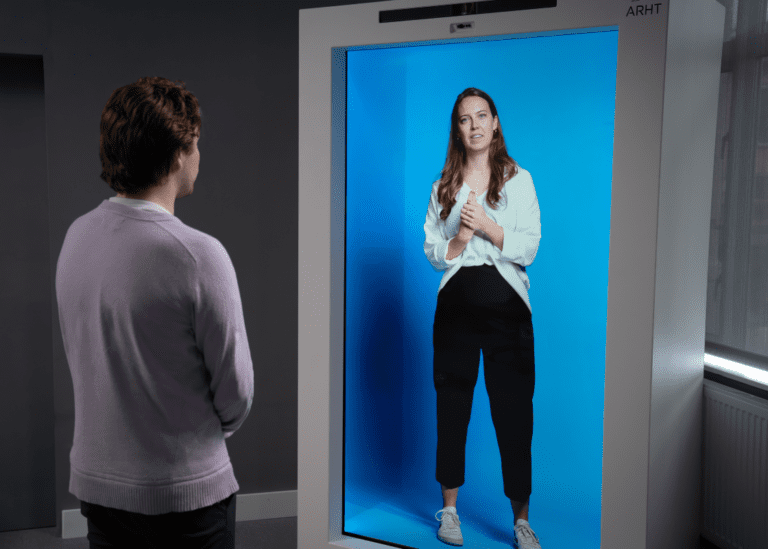
- As organizations embrace remote work, some are experimenting with hologram technology.
- ARHT Media, a global tech company, invited Insider’s Rebecca Knight to try it out.
- Here’s what that experience was like.
Top editors give you the stories you want — delivered right to your inbox each weekday. Email address
By clicking ‘Sign up’, you agree to receive marketing emails from Insider as well as other partner offers and accept our Terms of Service and Privacy Policy.
As a journalist who covers careers and the changing workplace, I get lots of requests to attend industry conferences, moderate panels, and Zoom into webinars.
But it’s not every day I’m invited to become a hologram.
So when I received an email from ARHT Media, a global technology company, asking me if I wanted to not only interview a hologram but also turn into one myself, I instantly said yes.
Professional curiosity drove my enthusiasm. As organizations embrace the flexibility of remote work, many are experimenting with ways to amp up the production value on their special events and meetings, and hologram technology is gaining momentum.
Of course, there was also the novelty of it. The opportunity to see a hologram up close seemed so space-agey and cool.
Now that I’ve tried it, I admit that holograms are pretty awesome. But I think that in the workplace, at least, their wow factor will recede once the newness and sizzle wears off.
A very modern encounter
The interview took place on the 24th floor of a WeWork office in downtown Boston. ARHT has 19 holographic studios in WeWorks across the world, per a partnership that started in 2021.
The room looked a bit like a professional television studio. There was a massive green screen with bright lights and cameras at one end; the other end was dimly lit with a black mesh screen. A technician named Billy sat in the corner running sound with laptops and audio mixers.
The interview felt futuristic from the start: The black screen shimmered with dancing white pixels and I heard a “Beam me up, Scotty”-like sound effect. Then a hologram of Andrew Dorcas, ARHT’s senior vice president of sales and marketing, beaming in from the company’s headquarters in Toronto, materialized before me as a life-size, three-dimensional human.
Dorcas wasted no time in explaining why he believes hologram technology is critically important to the future of work. “Don’t get me wrong, it’s important to go to places and shake hands, but not every meeting and every event warrants that investment,” he said.
“Our technology is for that sweet spot in between: the meetings that matter — the ones you want to be there for, but for whatever reason, you can’t be.”
Dorcas is an expressive, energetic talker and he strode around the screen as he spoke. He had a total of 4½ feet to work with, otherwise he’d be out of frame. He could see me via one of the other cameras in the room.
Dorcas said the most common use cases for ARHT’s technology in the workplace are high-level executive meetings, company town halls, keynote talks, and employee onboarding. Clients include Novartis and DHL.
Holograms are superior to standard video calls because they make it easier for audience members to read body language, he said. “When I’m live in front of you, there’s better engagement, better retention of information, and better participation.”
He’s not wrong. Dorcas’ hologram was captivating. The tech is crisp and he looked real-ish, sort of like a Hollywood, technicolor version of a human. But did I forget I was talking with a hologram and not a person in the same room? No.
Holograms aren’t cheap, but neither is the alternative
Dorcas bets that holograms and related technology will one day become more prevalent in conference rooms, but for now the costs make them impractical for everyday use.
ARHT, for instance, rents its production services, and organizations can buy or lease its technology. For a day of production — a single presenter beaming to one location — the cost is roughly $25,000.
Meanwhile, the company’s “Capsule” technology — pristine, white projection boxes that look like swollen phone booths — rent for between $4,000 and $5,000 a month. The Capsules, which beam in people for real-time interactions as well as prerecorded presentations, are suited to sales demonstrations, retail events, and training.
None of that is cheap, but Dorcas said that the alternative of executives jetting from place to place is expensive and takes a toll, too. Many clients are drawn to try holograms for environmental reasons, he added. “We’re busier than we’ve ever been.”
Look, ma, I’m a hologram
I wouldn’t ordinarily get a chance to become a hologram for work, mainly because I’m not a high-flying executive who bounces from city to city for meetings, nor do I do sales or corporate trainings.
So it was a kick to try out the tech. I stood in the green screen area and seconds later, my hologram was projected onto the black screen. I posed; I paced; I bemoaned how the camera adds 10 pounds. It was not a Princess Leia moment.
I tried to imagine how my colleagues would react if one of the top editors at Insider gave a speech to the newsroom as a hologram. Most would be impressed by the technology — it feels so very modern and fresh.
But I doubt the awe would last long. At the end of the day, a talk from the top brass is still just that.
It’s still work, no matter how futuristic.
(this article was originally published on Mar 15, 2023: https://www.businessinsider.com/hologram-meetings-arht-job-future-of-work-wework-2023-3)






